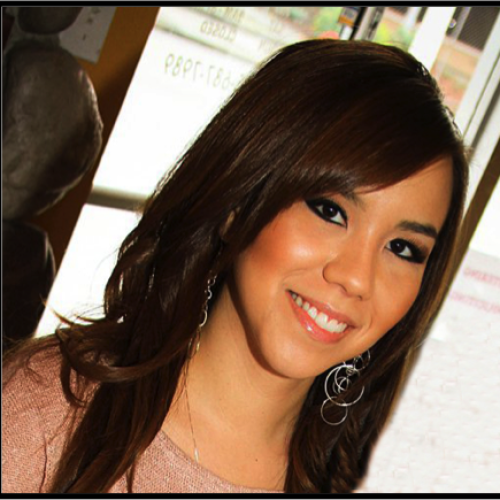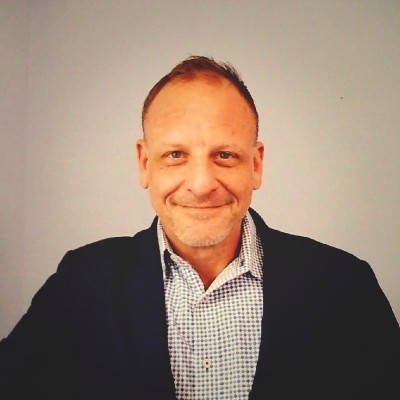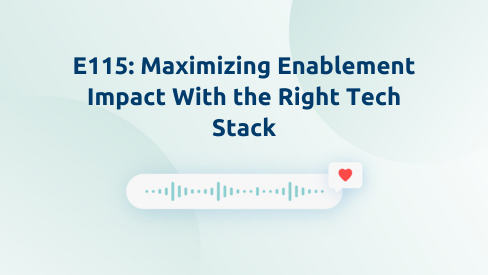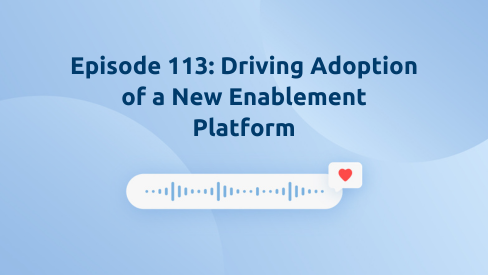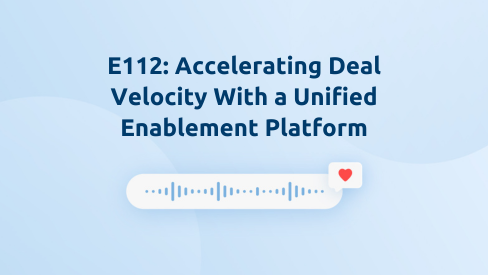Recent research from Sales Enablement PRO’s State of Sales Enablement 2023 Report found that organizations with dedicated enablement efforts report a 9-percentage-point increase in average win rates compared to those that do not. So why is enablement mission-critical for organizations today?
Shawnna Sumaoang: Hi and welcome to the Win Win Podcast. I’m your host, Shawnna Sumaoang. Join us as we dive into changing trends in the workplace and how to navigate them successfully. Here to discuss this topic is Ryan Kolofsky, the senior director of sales enablement at Kalderos. Thanks for joining, Ryan! I’d love for you to tell us about yourself, your background, and your role.
Ryan Kolofsky: Thanks for having me. My name is Ryan Kolofsky. I’m in Tampa, Florida. I work for a company called Kalderos. Kalderos is a software company that helps find drug discount noncompliance by working directly with drug manufacturers, payers, and covered entities, and we help limit costly non-compliance in Medicaid and the 340B programs. Our ultimate goal is to increase transparency with drug discount programs and build trust in these programs. It’s a very complicated market, but that’s what I do.
I have about 20 years of learning and development training and started out as a regular trainer, then moved up into L&D and learning development. Then I was on the cuff of when sales enablement became a thing. It was not even a call to sales enablement. I think my first job was called a sales enablement officer I worked for a software company at the time and they were realizing that they were spending most of their learning and development budget on the sales team. It was being sucked up by the sales team.
I think someone got a great idea somewhere and said, hey, let’s dedicate a person that just works strictly with learning and development, but is geared towards the sales team. I never looked back. That was probably about 10 years ago and growing up through the ranks and seeing a lot of things. I am happy to be here.
SS: Welcome Ryan. Now, I’d love to start off by understanding why enablement is a mission-critical function at any organization.
RK: I think it’s the bridge between everything. We usually sit in the middle and I used to say I’m a liaison between sales and marketing, but it’s grown much more than that over the years. It’s become a liaison between marketing, sales, product, sometimes HR onboarding, and stuff like that. I think it’s getting the salespeople up to speed and as quickly as possible from the minute they get in the front door to the time they’re selling that first deal and making revenue for the company.
We basically work with marketing and one of the things I can see is mission critical is like marketing. When I first came into many organizations, they would build out a piece of content. They would build out a white paper or an email template, and they would release it to the sales team at like a sales meeting, and it got looked at for like 10 minutes, and then it just got filed in the back of their sales cabinet, and then never got used again. One of the main things I think makes it so critical is when marketing spends all that time on the great content that they’re putting out there, we take the time to not only show it to the salespeople but train them on it and give them an easy system where they can find it and when they need it the most. One best parts about sales is just having the right content, the right time, and the right knowledge. I think it helps tie it all together.
SS: Fantastic. Now, in your opinion, what does good enablement look like? In other words, what are some of the key components of an effective enablement strategy?
RK: It’s an orchestrated strategy to equip sales teams and the tools and the knowledge they need to engage with potential customers at the right time effectively. I think it includes everything. It includes not only getting the marketing material in their hands quicker, so they can get it out to customers or they can promote it for customers. It’s also getting the product knowledge they need, building on customer persona to make sure that they’re trained up and they know how to talk to the different people in the different industries. They’re working on old-school objection handling, being able to overcome those objections, and giving them the right things to say at the right time.
SS: Absolutely. Now, you were familiar with Highspot in a previous role, which led you to bring it on when you joined Kalderos. Why was Highspot a must-have for your enablement tech stack?
RK: It was actually a must-have for me. Actually, when I was recruited to Kalderos, I said, How soon can I get Highspot, or how soon can I get a platform to help me out? I had just had it at multiple companies before Kalderos, and It was the same use case. You walk in, everything’s on either OneDrive or Google Drive, and it’s all over the place. Documents are out of date, they’re using the wrong content. You have no learning development system that’s not only like an LMS, but a learning system that’s geared towards sales. There’s a lot that goes into that versus a regular learning system. Highspot is a great training and coaching platform. Outside the HR initial onboarding, we had nothing, so I built that from scratch and used Highspot all along.
SS: I love to hear that. Now, getting buy-in for a new tool can be tricky. How did you partner with your sales and marketing teams to gain buy-in for investing in an enablement platform?
RK: My boss had also used Highspot at one other organization, so the buy-in from there was really great. My product marketing person, who is like my right-hand person, believed in it from the very beginning. It was like a conservative effort. I think getting buy-in from the sales reps is having an easy system, having something that they can use and be timely with, but also it comes from senior management.
I am very in tune with my sales leaders. It helps when the sales leaders are constantly pushing them back to a system or pushing them to take their training in the system or to go back and ask Did you look at Highspot first? That’s really helped with the adoption. I think the buy-in, though, is when they first start using it and they really realize the benefit they can get out of it. They just keep coming back and back.
SS: I love that. Actually, that segues really well into my next question, because since implementing Highspot, you’ve achieved 86% adoption of the platform, which is amazing. What are your best practices for driving adoption?
RK: It has to do with the senior management. You’ve got to get them involved. I mean, it’s the point where I’ve even had the CEO pushing Highspot and saying go look for it at Highspot. I think the adoption comes from once you’re getting them there to make it resourceful to them, to make it something they can use. I’ve been at other organizations where I’ve gone in and redone platforms because there was no adoption. Once you’ve worked on it and made it easier for them to find stuff in there, they definitely will come back.
There’s also, like I said, forced adoption. The senior leadership pushed them back at it. What I mean by that is, if they have a sales deck and the original up-to-date one is on Highspot, and when a rep comes to them and says, hey, do you have that sales deck that I’m looking for? They just don’t send it through an email or Slack. They send it through the link either to Highspot to find it or the question goes right back to them. Have you looked in Highspot? I think that has helped.
SS: Absolutely. Another key win that I had heard about within Kalderos is that you have driven a massive increase in pitch adoption through training that you actually delivered at your sales kickoff this year, which has led to a 5x improvement in buyer engagement. Can you tell us about this program and its impact?
RK: At Sales Kickoff, we were very fortunate to have Jonathan, who works for Highspot and lives in Chicago, where our company’s based, and he was able to stop by at our SKO. We did about a two-hour workshop on pitching and introducing it to the teams. I think that one of the biggest things that led to the increase was we had some early wins right off the bat. We’ve had people sending out pitches to companies and where they’re not opening emails, they’re opening them up and they’re looking at the content. I think you find those wins and you publicize those throughout your organization. Other salespeople love it when another person has success and they want the same success. They start to ask how’d you do that? What’d you do? Show me how to do it. I think that was one of the things.
Also, I can say to never give up pushing pitching. There were many times where I said, oh man, they’re going to use outreach, they’re going to use this, they’re going to use that. It’s getting them almost out of their comfort zone to try something new. I think a lot of people get discouraged too early and they just let the salespeople keep doing it their own way. I was adamant about it so much that my team used to call me the Highspot guy. Every single time I’d say ‘use a pitch, it looks more professional. It’s a better way of getting them.’ It just pushed them so much that they finally would end up using it and we would offer spiffs around people getting their emails opened up or their pitches opened up and people who got view content.
Like I said, I got a couple of quick early wins with that. We just kept on and kept on reusing those templates and reusing the pitches for the team. We also had to share best practices, like they would share pitches with each other. I think that really helped out that.
SS: I love that. I know that obviously the training component played a key role in the success of the initiative and continuing to drive that education to your base around the importance and the value of this. You actually increased active learner rates by 71% with Training and Coaching in Highspot. Can you share your best practices for delivering effective training in Highspot?
RK: I would say, again, always be aligned with your sales leadership or constantly asking the reps, what they need and what’s going to make them successful. I think too many enablement people and too many people in general, when they’re dealing with a sales team, they think they know what they need and what they want. They fail to ask the team, hey, let’s have a round table. Let’s talk about it. What do you guys need? What do you want to train on? Where are your gaps? Aligning with them makes training important to them and makes it very interesting to them.
You can take a shot in the dark and hope you hit the point. If no one goes into your training or they walk away from the training, getting nothing out of it, that’s your fault because you didn’t include them and you didn’t ask them what they wanted to be trained on. I think you always have to provide value to the reps when they go in there every single time. I update the front page of Highspot. I have a learning development page with new courses coming out, and new courses we’ve assigned, and every single time they go in there, hopefully they find something valuable or it’s up to date with a current problem they’re trying to solve.
Keep the materials up to date. Always keep it exciting and interactive. One of the main things I love about the training and coaching is the ability for them to record themselves and send that out for feedback from their sales leadership. I think that was one of the key things that I was looking for before. Even Highspot didn’t have a training and coaching platform when I was the first one to use it. The reason why I really adopted and used it very quickly is because they record their sales pitch, not a pitch, but their sales pitch and send it to their peers and get feedback from not only their sales leadership but from their peers as well.
Also creating certification programs, I think was a huge hit. Before I came to Kalderos we had no onboarding, so we built that from scratch. We also didn’t have any post-onboarding when they were finally getting into the real world and they’re pitching customers. We have a certification program now that they have to do a live presentation and record it and then it’s sent to senior leadership for review. We then do another after they do the recording. Then we have a session live where they have to pitch as far up as the CEO, and they get certified in their first call pitch certification. We’ve grown on that concept along the way where we have certifications like demo certifications and we have persona certifications, so I think that really keeps them coming back.
SS: I love that. You alluded to this just a moment ago, but you were one of the original beta users for Highspot’s Training and Coaching functionality and you’ve really grown into a power user. What advice do you have for other people who are just getting started in Training and Coaching?
RK: This is my favorite one. When I first started in Training and Coaching, I was all about making lessons and making courses. I would put together these great courses or great lessons and they would go through them, but I really never saw the value or I’d miss the value in creating sales plays. I can’t tell you how many times I’ve done great training and the sales reps said, hey, there was that great article that was in that training. Where do I find that? Where is it?
What the plays give me the ability to do is to make a resource page which I like to call a one-stop shop. If we have product training on one of our products, we have sales training on one of our products, we’ll make a product training play and we’ll make a sales training play. We just partnered with Corporate Vision, so we have a lot of the methodology plays in there. It just makes a big difference.
I think that was the biggest thing. I even stopped myself today, like I’ll start to build out a course and be like, oh no, I need to do a play first and then I’ll build out the course. That was one thing, A commitment I made to myself is like, I won’t build out any more courses unless there’s a play that goes along with that. That gives them the ability just to go back and refresh on that content. One of our big initiatives this year is to use the Salesforce integration and integrate those plays within Salesforce so they can see those when they need them. It’s timely, it’s in front of them, it’s a refresh in honor.
SS: Very cool. I love how you used Highspot’s Training and Coaching and Corporate Vision’s sales methodology by leveraging the Highspot Marketplace application to drive that training across your teams. Tell us a little bit about what that process was like.
RK: I’ve done launches before sales methodology, and it’s usually a good workshop, and you do a post-workshop activity, and the reps see it one or two times, and it’s not really reinforced. What the CVI partnership has done for us with Highspot is to have that online training first, and we’ve done a lot. We’ve gone through a lot of the methodology training, like the first two steps of methodology training, and we’ll do them, assign it to the team, and the training is awesome too. It’s really well done and it’s up to date and it’s very well orchestrated. It’s very interactive. It grabs their attention.
Once they take that training, we will do a live workshop and then we will post stuff. We just launched our why change operation message. We first did the why change training online, which is general and tells you about the concepts. Then we had a live workshop. Then after that, I built out an operations change message certification in Highspot where they need to identify a company that they’re going to pitch that operations message and they need to fill out a wide change planner in Highspot and they take that planner and they do their deck and all the stuff they found from doing that deck, then they have to pitch, record pitching, and that’s going to be sent out for. Then they have to actually go all the way through and pitch that company live at the end of it. That’s how they get certified in it. We have Gong, so we can listen to the recordings and calibrate there as we need it.
We have a bunch of different messaging and I think it really helped us get aligned on how we’re going to talk to our customers pre-, during, and post-sale. I think we actually have our customer success team now using Highspot and they’ve been on some of the why change trainings with us. It’s really neat when you have the ability to bring everyone together on that same message. Like I said, I’ve rolled out methodologies before and it’s hit or miss. They adapt for a little while and they go back to their old traits. Well now, even when I build out a play, it’s built out with CVI methodology in it. I think it really helps. They have a better understanding of how that call flows and that messaging works when they see that.
SS: The next question I wanted to just kind of understand from you is where do you see training making the biggest impact in your business right now?
RK: Right now at this very moment, I would say we’re getting ready to launch a new product in September. We have a pretty complicated industry and there’s a lot to learn. I think without training, reps would be winging it and they would try to understand. I think it’s making the biggest impact now because I have my product marketing person, like I said, who is like my right-hand person in Highspot. I’m in Highspot. We’re putting everything together in Highspot. We have the ability to do the recording pitches and have them pitch the new product. I think it’s making the biggest impact right there right now.
Also, the plays, like I said. I was a late adopter of plays and I wish I had done it earlier because they make a huge impact. I love the fact that you can see all the analytics behind that play. You can see who’s looking at what and what content they’re using. That’s a big lever to pull when you’re trying to figure out, hey, do they like my training? You can always send out a survey, but having the analytics behind that play to see what they’re actually looking at and see even how many people have viewed it, I mean, that’s golden to me.
Training is great. You train and they certify and then they’re done, but to be able to have a place where they can jump back out of that training and review the stuff they’ve done and go back when they really need it. I think when the rubber hits the road is when they have the training, but when they get in front of that customer it’s like, okay, it’s gone time. I love the fact that they could look at a play 10 minutes before they get on that call give themselves a refresher and get themselves ready and ready to go on that call. I think it makes a big difference.
SS: Absolutely. I think it’s phenomenal how Plays help guide reps in real time because a lot of training is easily forgotten after an amount of time. I think you’re spot on when you say Plays help to give those reps that real-time training right before they walk into a discussion with a buyer.
Now, last question for you, Ryan. You have built a lot of momentum around leveraging Highspot, and you talked about this just a moment ago with the scorecard analytics on Plays, but how have you leveraged analytics to make strategic decisions related to your enablement strategy?
RK: As I said just previously in the plays, I think that’s one of the biggest places we are leveraging the scorecards of those plays and looking and seeing what the reps are looking at and what they’re not looking at, even more importantly. We think we have it figured out and we know what the reps need and what they want, but the analytics helped me really fine-tune that to see what they are really looking at. Sometimes it’s depressing when you put something out there and you don’t get as many views as you thought you were going to go on it, or you put a piece of content out there that doesn’t get any views.
At the end of the day, how we make them better is by them providing feedback to us and really telling us what’s working and what’s not working. A lot of times you can’t corner reps to get that feedback back from them. The analytics helped me understand what was important. What’s not important? What needs refreshing? What do we need to retrain on that stuff? I think that’s one of the biggest things.
SS: I love that. Ryan, thank you so much for joining us today.
RK: You’re welcome. It was fun. Thank you.
SS: Thank you for listening to this episode of the Win Win podcast. Be sure to tune in next time for more insights on how you can maximize enablement success with Highspot.
